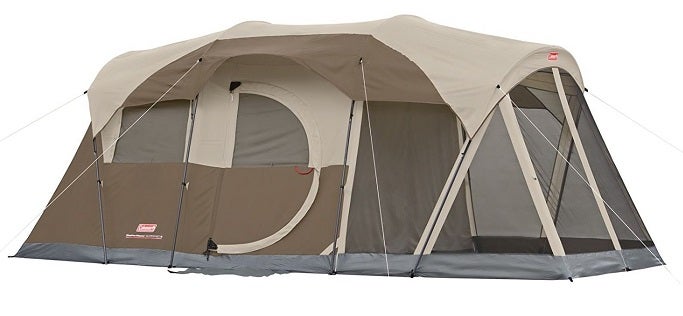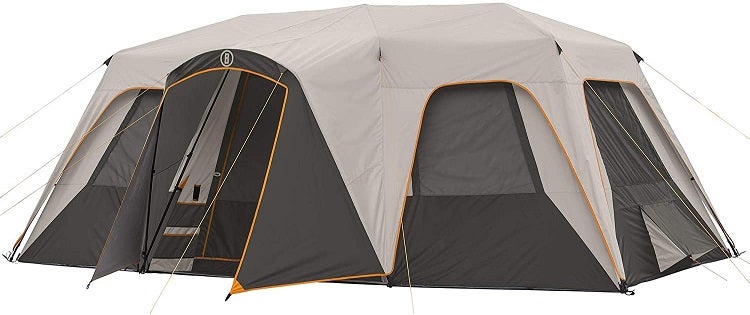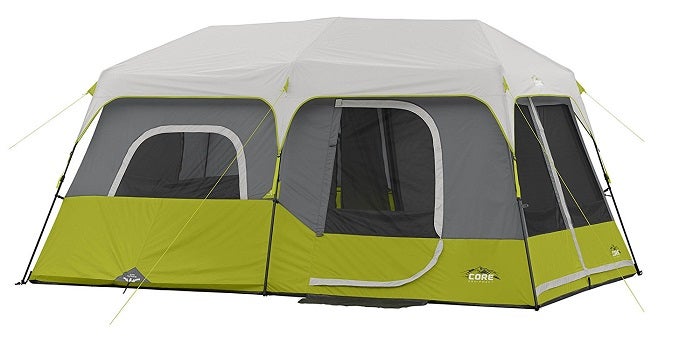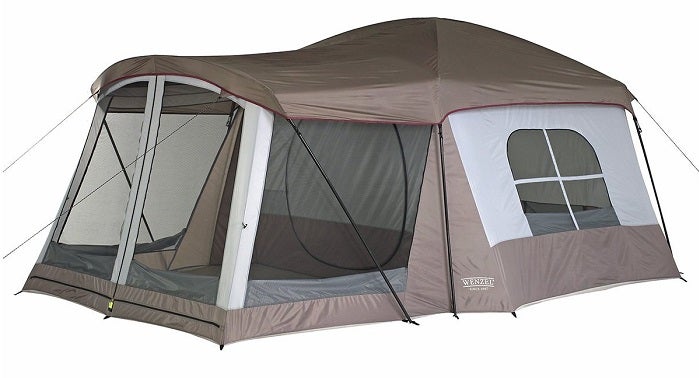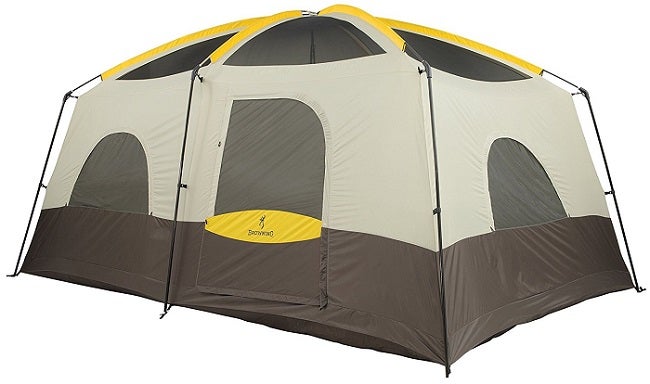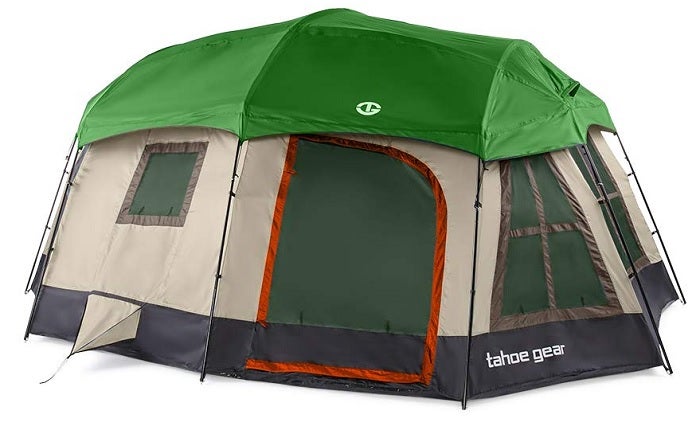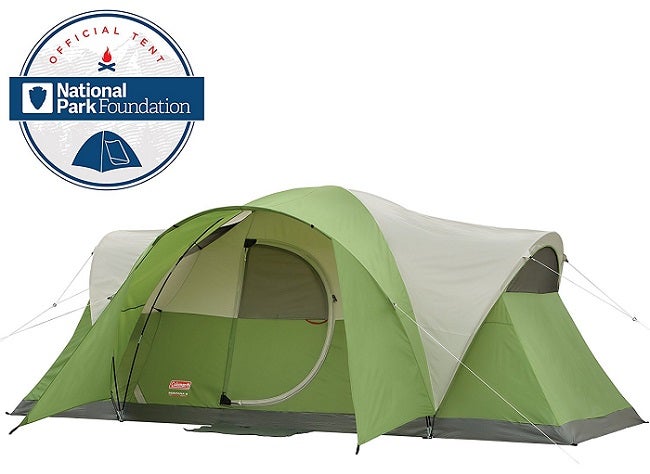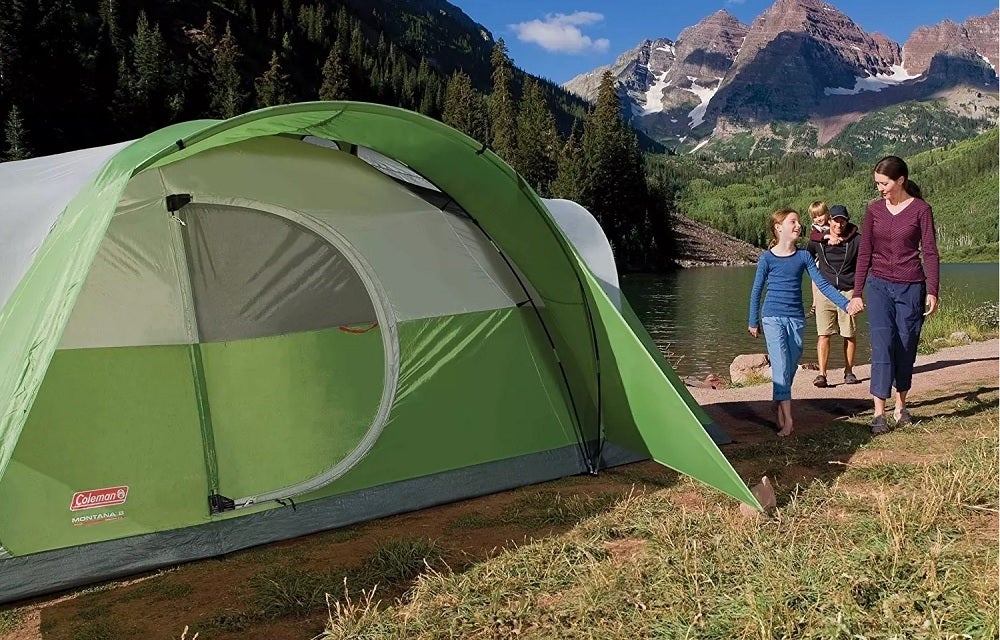
Our Editors independently research, test, and rate what we feel are the best products. We use affiliate links and may receive a small commission on purchases.
When it’s time to hit the campground, park, or trail with the family you’ll need the best family tent to do so! If you’re like me, you may not have the cash on hand to buy or rent an enormous RV.
Sure you can quickly and easily get a large tent without too much cost. But, how can you be sure that it’s not a piece of junk?
With hundreds of nights spent on the trail guiding backpacking trips, I know what makes a good tent stand up to the tests of the wilderness. I’m going to guide you through the process of choosing a family camping tent for your needs.
Best Family Camping Tents
For more of my camping gear recommendations, have a look through these popular Outside Pursuits guide links: Coolers, Lanterns, Stoves, Hammocks.
Quick Answer: The 7 Best Rated Family Camping Tents
- Coleman 6-Person WeatherMaster Tent
- Bushnell Shield Series Instant Cabin Tent
- CORE 9 Person Instant Cabin Tent
- Wenzel 8 Person Klondike Tent
- Browning Camping Big Horn Family/Hunting Tent
- Tahoe Gear Ozark 3-Season 16 Person
- Coleman Montana 8-Person Tent
Our reviews of the top rated family camping tents with our comparison table and buyers guide will help you choose the right tent for your family.
Family Tent Reviews
#1 Coleman WeatherMaster Family Tent
- Welded bathtub floors
- Seperate screen room
- 11’ x 9’ floor footprint
- Sleeps 6 people
When a tent says it has enough room for two queen size air beds, you know it’s big. But is bigger always better?
Well, when it comes to having room for the whole family and enjoying your weekend getaway, it just might. Where do we even start with this behemoth of a tent?
Alright, so about ⅓ of the tent space is going to be used up by the floorless screen room.
Keep that in mind when planning sleeping arrangements. However, if you’re using cots or want to have a place to sit and eat or cook then a floorless screen room isn’t so bad anyways.
Up top the rain fly features an entryway awning which is a feature I really like. It helps keep a little more of the rain outside the tent when you enter and exit.
Overall this large camping tent is made from polyester and features tons of mesh ventilation. There’s lots of airflow near the top of the tent, too where it really counts. While the seams aren’t taped, they’re sewn inverted and this helps keep the needle holes hidden from water.
I would honestly have liked to see them tape the seams anyways, however I would say it’s the best family camping tent, especially considering its price!
Best For: Families looking for a large versatile tent from a great name brand you know you can trust.
#2 Bushnell Shield Series Instant Cabin Tent
- Instant “pop up” design
- Four large mesh windows
- Factory taped waterproof seams
- Three sizes: Sleeps 6, 9, 12 people
Born in the ruggedness of the Rockies, Busnell Canvas has quickly earned a reputation for making tough, long-lasting tents ideal for almost any camping scenario.
The Shield Tent is no exception – designed with 150 denier fabric with a reflective coating, this is a watertight tent that will stay cooler than than most other tents.
Being a large tent you expect a long and difficult setup but that’s not the case. This is a “pop up” instant tent meaning you can have it fully setup in a minute!
The poles come preattached to the tent, this not only reduces setup time, there is not losing the poles or trying to figure out where they go. Especially nice when you are setting up in the dark!
The floor is made of seamless puncture-resistant vinyl that keeps water out. The steep walls and 6’6” high ceiling provide a roomy interior with stand-up, walk-around comfort.
With a large front door with a top rated YKK zipper means easy opening and reliablity.
To aid with air flow, there are 4 windows and 2 vents, each covered with a mesh screen to keep out even the smallest bugs. If you want, it even has A/C vents to use with a portable air contitioner.
Better yet, this model comes with a handy strap-and-cinch bag for easy compact storage. What’s not to love? This is the best all-weather family camping tent on our list.
#3 CORE 9 Person Instant Cabin Tent – 14′ x 9′
- 14’ x 9’ floor footprint
- 2-room divider
- Sleeps up to 9 people
- Sealed seams and rain-resistant
This is one seriously large, spacious, and airy tent. If I was going to give an award for best cabin tent it would most likely go right here.
Plus users absolutely rave about the quality and price of this tent.
Okay, let me preface by saying that I don’t recommend packing in like sardines. However, the floor plan of this large family tent does allow enough room to cram in up to 9 people! Not bad.
For those luxurious trips where there’s actually nearby access to electrical service, this tent does have a closable electrical cord port. That means you can run a dedicated extension cord from the service box.
Personally, I like the quick and easy pole setup this tent uses. It makes the poles a bit bulkier, but the instant setup poles are handy.
If I had to pick one thing about this large family tent that stands out as a negative it would be the “water resistant” rating. Whenever I see a manufacturer dodging the “waterproof” advertising it worries me – there’s usually a reason they won’t advertise it as waterproof.
Best For: Camping in pleasant weather with huge groups!
#4 Wenzel 8 Person Klondike Camping Tent
- 16’ x 6.5’ floor footprint
- Large screened room
- PU coated polyester
- Sleeps 8 people
No matter what your budget may be, it’s not hard to say that this is the best 8 person tent that is affordable for the size and quality.
Further, I think many will like the house-inspired design that makes your camping trip feel like you’ve got all the comforts of home.
There’s no question this time – we’ve got a waterproof tent on our hands. Polyurethane coated polyester fabric is one of the best waterproof fabrics available at a budget price.
However, just because it’s waterproof doesn’t mean it’s a good choice for you.
The large footprint is heavily consumed by the large screened in porch area. While it has a waterproof rainfly over it, the walls aren’t waterproof. You’ll only want to sleep out there in good weather.
All that said, users do seem to complain most about the durability of this tent in the wind. Of course, who knows if they actually set it up properly… so as a word of caution make sure you use good, durable tent stakes and master the important knots you need to know in order to secure your tent (such as the trucker’s hitch).
Best For: Sheltered campsites where rough winds are unlikely and large porch space is ideal.
#5 Browning Camping Big Horn Family/Hunting Tent
- Fiberglass and steel poles
- 10’ x 15” floor footprint
- Two entry doors w/ inner divider
- 6 Windows and mesh roof
Browning might not be the first name you think of when you’re looking for a tent, but think again.
Browning makes this large family tent for hunting or camping when you need a large base camp for tons of people or supplies.
Whether you want one big space or two divided rooms, you can use the optional divider to segment up the space. This is handy for multiple couples or families with older kids who want their own space.
Nearly the entire roof is mesh so you’ll want to get that rainfly on right away. Surprise rain showers will show up and ruin your day because getting this enormous 10’ x 15’ rainfly on and secured is no quick job!
I love the large bathtub floor and door awnings which provide a little more rain protection than some others.
Unlike many makers Browning specifies this as a perfectly acceptable 150D polyester fabric with a 2,000mm waterproof coating. If you’re looking for the best family tent, you found it!
Best For: When you need one of best family tents for camping that is truly waterproof with reliable construction that you can trust to get the job done right!
#6 Tahoe Gear Ozark 3-Season 16 Person
- 1,200mm waterproof polyester fly & tent body
- Divided rooms
- Bathtub style floor
- Sleeps 16 people
I’m not sure where tents stop being tents and become fabric houses… but surely this is close. With a 7’ tall center and room for up to 16 people, it’s hard to even comprehend that this tent is anything short of a cabin in the woods.
At nearly 16’ x 16’ in size, this huge camping tent puts up a generous 250+ square foot floor space.
That’s bigger than many people’s living rooms. It’s also plenty of room for the divided interior to segment off spaces for couples or kids and families.
I do like that there’s a ton of mesh for ventilation. The entire ceiling is open so be sure to put up that rainfly early in case of freak storms!
On the floor there’s a waterproof bathtub style flooring that comes up all sides of the tent to keep water out. According to Tahoe, this tent is also made from waterproof fabric all around. That means tons of protection from nasty weather for everyone inside.
Best For: Anyone looking for the best large camping tent and needs protection from the elements!
#7 Coleman Montana 8-Person Tent
- 16’ x 7’ floor footprint
- Extended door warning
- Room for 3 queen air beds
- Sleeps 8 people
Coleman is a name you can get behind. Everyone knows them and they were even the first tent on our list. So for families on a budget that still need elbow room, the Montana might be a good choice!
Like the WeatherMaster tent, the inverted seams on this tent keep costs low while keeping water out. That’s good news for you because it means an affordable yet quality tent.
On top of that, the rainfly is rather generous and extends out over the front of the tent,
This creates a waterproof entryway where you can take off your raincoat and shoes before going into the tent. You’ll love this feature if you regularly camp in rainy areas.
Coleman has responded to user feedback and recently redesigned this family tent to have stronger poles and more ergonomic guylines that can absorb wind forces.
Paired with the protected zipper flaps and waterproof flooring, make this the best car camping tent that can handle nasty weather!
Best For: When you need one of the best tents for families that is waterproof and generously sized for families in rainy climates.
Family Camping Tent Comparison Table
| Family Tent | Sleeps | Dimensions | Waterproof | Rating | |
|---|---|---|---|---|---|
| Coleman WeatherMaster | 6 | 11 x 9 feet | Yes | 4.2 / 5.0 | |
| CORE Instant Cabin | 9 | 14 x 9 feet | Water resistant | 4.6 / 5.0 | |
| Wenzel Klondike | 6 | 16 x 11 feet | Yes | 4.0 / 5.0 | |
| Browning Camping Big Horn | 8 | 10 x 15 feet | Yes | 4.4 / 5.0 | |
| Tahoe Gear Ozark | 16 | 16 x 16 feet | Yes | 4.0 / 5.0 | |
| Bushnell Shield Series Instant Cabin Tent | 6, 9, 12 | 18 x 11 feet | Yes | 4.5 / 5.0 | |
| Coleman Montana | 6 | 16 x 7 feet | Yes | 4.0 / 5.0 |
How to Choose a Large Tent For Family Camping
- Tent Materials
- Tent Rain Flys
- Ventilation
- Waterproofing
- Tent Vestibules
- Tent Height
- Pole Attachment
- Tent Poles
- FAQs For Family Camping Tents
- Conclusion
We’re going to look at both the criteria for a great family tent and you’ll learn all the pro tips I can give you to make sure your next adventure is smooth and fun!
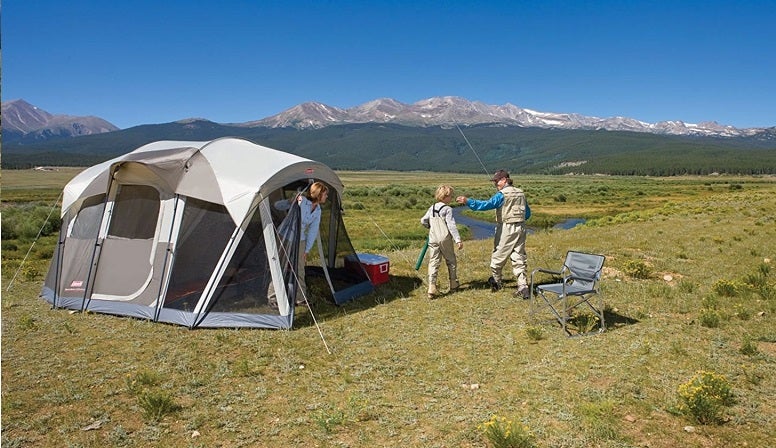
Camping Tent Materials
When it comes to choosing a tent material, you have two main choices. Either your tent is likely to be made of nylon or polyester. Both materials have pros and cons.
Nylon is very strong and abrasion resistant. Generally speaking, it’s hard to go wrong with nylon as a tent material. It’s inherently quite waterproof and windproof. Of course, it still needs to be properly treated to be fully waterproof.
Polyester can be a bit cheaper in lightweight tent or tarp materials. While it’s not as strong as nylon, it’s still a perfectly great choice for tents. Manufacturers may use polyester to keep costs low while still making a good, lightweight tent.
Either material choice is fine. For most family tents, the focus is on durability and affordability. Most manufacturers prioritize these qualities above others so you’ll likely be stuck with whichever material suits your new tent the best.
Tent Rain Flys
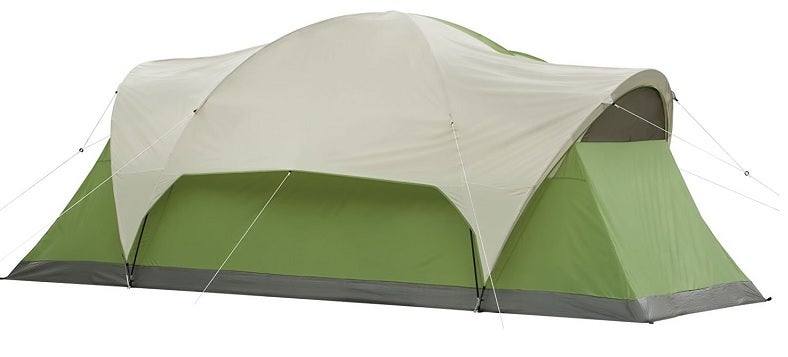
Rain flys are the part of the tent that provide an extra layer of waterproof protection. Most tents have double wall construction. This means the inner wall is breathable – often with mesh windows – while the outer wall is usually the waterproof rain fly.
Why is it this way?
Because waterproof fabric doesn’t let water through, an enclosed family camping tent would be stuffy, sticky, and moist if there wasn’t some ventilation. Rain flys block water without turning the tent into a plastic bag!
Look for rain flys that are large and generous. There’s no reason to struggle with a rain fly that barely covers the critical areas of the tent. In fact, I prefer rain flys that have awnings and hoods which help stick out over the doors and windows.
These small luxuries may cost a bit more, but they’ll make your life in the outdoors more enjoyable.
Tent Ventilation
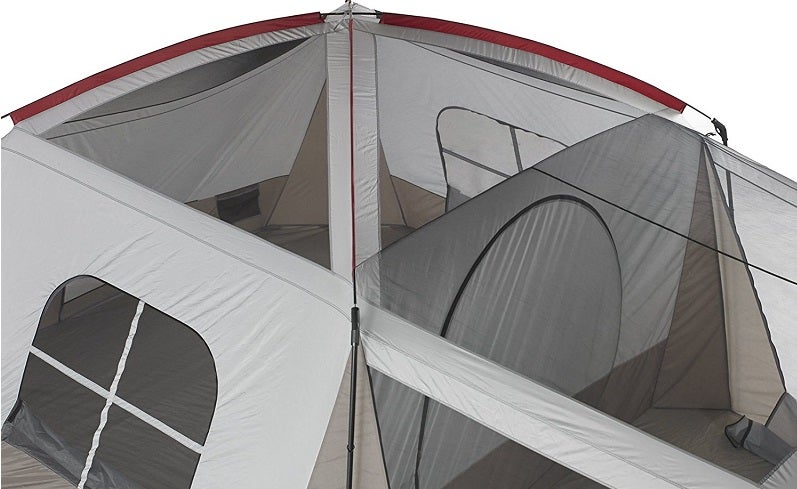
We talked briefly about ventilation in the previous section. For cabin tents, ventilation can make or break the deal.
If you’ve ever gone camping and woken up with dew on the walls, running down or dripping on your face you’ve had a tent with bad ventilation. In order to solve this problem, look for a tent with adjustable ventilation near the top and bottom of the tent.
Many tents have zippered windows that you can adjust for lower ventilation. The important part, however, is the ventilation near the top. It’s important to have generous ventilation near the top of the tent where heat and body moisture build up.
To be sure your tent will perform well, check that the rain fly won’t block the upper ventilation. Well designed rain flys accommodate the ventilation on the upper tent with flaps or standoffs that leave room for proper airflow.
Waterproofing
This is an important factor in any tent – maybe the most important. However, too many campers don’t know how to double check that their tent is in fact waterproof. Any tent can say it’s “waterproof” but how can you check the quality of the waterproofing?
You want to look for confirmation that your tent is made from waterproof fabric such as silnylon or silpoly in the areas where it will get wet.
Tents also often use waterproof “bathtub floors” which can be made from various waterproof materials as well. If the description or specifications don’t specifically state the type of waterproof fabric, be wary.
Once you’re sure that the tent fabric is actually waterproof, check for seam sealing. Cheap tents that seem too good to be true often skip this step. Seam sealing is important because anywhere that waterproof fabric is sewn, holes are introduced into the fabric by the sewing needle.
To fix the problem of needle holes, tents are seam sealed or seam taped. Waterproof tape is applied right over the seams and then glued in place with special waterproof adhesive. If this tape is not there or if it becomes weathered with age and peels off, your tent is no longer waterproof.
Tent Vestibules
A vestibule, as it pertains to a tent, is a covered area like a porch. Not all vestibules are large enough to stand in – often they’re just big enough to keep rain out of the tent as you enter.
One thing all vestibules have in common is that they’re great areas to store gear outside the tent. For smaller tents, you would usually simply store a backpacker or wet shoes in the vestibule.
Some larger family tents have vestibules that are full height and large enough to even set up a table. In this case your vestibule is more like an actual porch! Beware, though, as driving rain and wind can wreak havoc on things stored under an open tent “porch” like this.
Tent Height
There’s a good chance you’re not thinking about how tall your tent will be. It’s an important consideration that will tell you a lot about the capabilities of the tent you’re considering, though.
Some family sized tents feature full-height ceilings that push 6’ – 7’ tall. Traditionally, most tents have a rounded ceiling shape, however, so these full height ceilings are anything but full height by the time they intersect with the walls.
Today manufacturers are opting more for straight wall and flat ceiling tents to preserve as much usable space as possible inside the tent. This means a 6’ tall ceiling will be (nearly) 6’ tall at all points.
It’s a great feature, but it comes with one major drawback. This flat wall, flat ceiling design makes these large tents virtual cloth sails in strong winds. Be careful where you set your tent up and try to shelter these large straight wall tents in areas where they won’t be buffeted by full-strength wind gusts.
Pole Attachment
When you’ve got the entire family running around the last thing you want to do is spend time fumbling with setting up the tent. For that reason I think we should all pay attention to how the tent actually assembles when joining the poles to the tent body.
To attach your tent poles to the tent you’ve usually got one of two options:
- Tent pole sleeves
- Tent pole clips
Tent poles sleeves are round tubes of fabric into which tent poles slide. You then assemble the rest of the tent. Sleeves have a tendency to be tedious and frustrating to set up, frankly. Overall, however, they may be slightly more durable and stronger than tent pole clips.
Tent clips are sewn in at intervals along attachment points. They’re much easier to use when setting up the tent and quite a bit faster than sleeves. Their only real downfall is that they may be slightly weaker than sleeve construction during storms though a properly constructed tent should have no problem with this.
Pro Tip: Pair tent clips with hub-assembled tent poles for super-fast foolproof tent setup that will make you look like an outdoor hero!
Tent Poles
Normally tent poles are made from fiberglass or aluminum. They’re small, lightweight, and easily bendable to support the structure of the tent. These kinds of tent poles, however, are often too flimsy to support the larger bulk of family size tents.
Instead, many family tents have large sturdy poles that are meant to bear the weight of the tent in the rain and wind. Because of the sheer size of many larger family tents, the added weight of sturdy poles can’t be avoided. If you’re used to the thin, lightweight poles of smaller tents, you’re in for a big surprise here!
I actually think larger, sturdy poles are better in this case. Because these tents are so large and bulky, they’re not meant to be lightweight and small. For that reason you’re not likely to move them far from the car or truck to the setup site.
If you want the best convenience, some tents are now coming with pre-assembled poles. These poles quickly break down into packable size, however there’s a catch. These easy to use pole systems have a fool-proof locking mechanism that quickly joins them all back together again without guessing at which poles go where.
Different manufacturers have different names for these easy to use pole systems, but keep an eye out for them as you shop around!
FAQs For Family Camping Tents
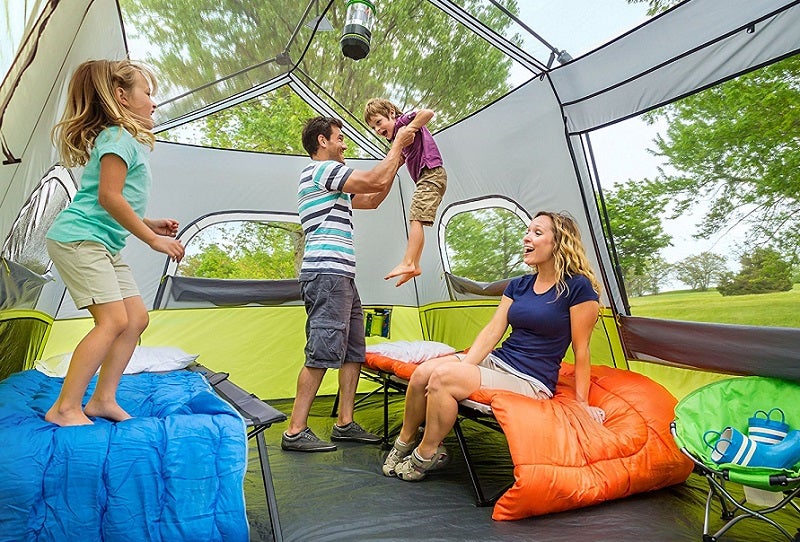
Q: Can I cram the max number of people into my tent?
A: No! The max numbers that manufacturers advertise is just that – advertising. They calculate these numbers based on users sleeping in the tent packed in like sardines. To be comfortable in any tent you’ll want to think about how you sleep – will you use sleeping bags, sleeping pads, cots? Will have a camping chair inside?
These all affect that overall numbers you can fit into any tent.
Q: Should I use the tent stakes that came with my tent?
A: Probably not. Most stock tent poles are just junk and you’ll be frustrated when they break.
Get some good, sturdy steel tent poles that you can hammer into hard ground. Aluminum and plastic can’t stand up to the abuses of being hammered into the ground and you’ll be pissed when they break on you.
Always drive your tent poles at an angle and use a knot like the Trucker’s Hitch to provide tension on your guylines.
Q: Are these tents good for hiking?
A: No. These tents are massive and heavy. They are meant for family camping when you’re taking the car or truck to a campground. They’re much too bulky for hiking or backpacking.
If you’re looking to take the family backpacking, you can find 4-person backpacking tents that will work for you. These are the wrong tents for portable needs.
Q: Can I use my tent in the snow?
A: You can use your tent in the snow. What you want to avoid, however, is using your tent while it’s snowing.
All of the tents on our list are meant for 3-season use. That essentially means they’re not strong enough to handle heavy snow loads.
The problem with snow on tents is that loads of snow can slowly pile up on flat surfaces. Even an inch of snow (often less) can weigh a lot when you add up how much of it can pile up on top of a large tent roof. That extra weight is enough to break tent poles which aren’t designed to handle snow loads.
Winter tents, known as 4-season tents, usually have a strong, rounded or angular design that sheds snow. Paired with stronger poles, these tents can stand up to winter weather!
Q: How do I make my tent waterproof?
A: You don’t. Start by buying a tent that’s already reliably waterproof. If it’s not waterproof from the factory, nothing you can do will make it become waterproof.
That said, if your tent begins to lose waterproofness over time here are a few things you can try:
- Use silicone seam sealer to patch seams
- Use nylon patches with silicone seam sealer to patch tears or holes
- Use a spray-on DWR coating to restore some waterproofness to the tent body
Starting with a quality waterproof tent is the best way to make sure your tent is and stays waterproof.
Outside Pursuits Overview
These family tents range from 2-4 people to 16+ in size. Take it from me – size is a luxury when it comes to camping. A long weekend can be miserable cramped up like sardines in too small of a tent. On the flip side, however, you may be frustrated trying to deal with an overly large tent.
Keep in mind your family size and how often you’ll have extra guests. With that in mind, purchase a reasonably sized tent that can suit your needs with some room for expansion or guests.
Don’t expect your tent to last forever – see the FAQs for info on how to repair your tent over time. However, when you’re buying a tent make sure you don’t skimp on quality.
You’ll be glad you spent the extra buck when your neighbor’s tent is leaking on them in the middle of the night.
How We Researched
To come up with the top camping tents we researched a variety of sources for reviews such as REI, Bass Pro Shops, Cabelas and Backcountry along with our own personal experience.
We also consulted online magazines for product research and reviews to get as much unbiased information as we could. To help weed out fake reviews we used Fakespot.com to make sure we only looked at genuine reviews.
With so much quality gear available, we had to narrow it down based on what we felt were the best options for the price. The author, Casey Fiedler has been leading backpacking trips for over a decade in his native state of Michigan.
To help narrow down the selection he used his personal experience along with recommendations from fellow guides and outfitters.
After extensive research, we came up with our list to help you choose the right one for you.
Sources
I hope this guide was helpful in picking a large camping tent to fit your family’s needs. If you want to comment or recommend a tent I didn’t include, please use my contact form to get in touch.
Have fun and be safe out there!

